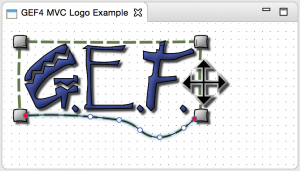Notice: This Wiki is now read only and edits are no longer possible. Please see: https://gitlab.eclipse.org/eclipsefdn/helpdesk/-/wikis/Wiki-shutdown-plan for the plan.
Difference between revisions of "GEF/GEF4/MVC"
m |
|||
| Line 7: | Line 7: | ||
The GEF 4 MVC component provides support for building up graphical editors and views based on a model-view-controller architecture. It provides toolkit-independent MVC-support (MVC) as well JavaFX-specific specializations (MVC.FX) and Eclipse UI-integration for both (MVC.UI, MVC.FX.UI). | The GEF 4 MVC component provides support for building up graphical editors and views based on a model-view-controller architecture. It provides toolkit-independent MVC-support (MVC) as well JavaFX-specific specializations (MVC.FX) and Eclipse UI-integration for both (MVC.UI, MVC.FX.UI). | ||
| − | == Example | + | == MVC FX Example (Standalone, Web, and Eclipse UI) |
| − | We currently provide | + | We currently provide a simple example (GEF logo editor) that demonstrates the interplay of all MVC components (i.e. MVC, MVC.FX, MVC.UI, and MVC.FX.UI), and is also based on the [[GEF/GEF4/Geometry | Geometry]], [[GEF/GEF4/FX | FX]], and [[GEF/GEF4/SwtFX | SwtFX]] components. It can be started as a standalone JavaFX application as well as integrated into a web page (via Java WebStart), the is an extension in the form of an Eclipse View (which integrates within the Eclipse Workbench operation history as well as the Eclipse UI properties view). |
| + | [[Image:GEF4_MVC_FX_Example_Standalone.png|300px]] | ||
| + | [[Image:GEF4_MVC_FX_Example_Web.png|300px]] | ||
[[Image:GEF4_MVC_FX_UI_Example.png|300px]] | [[Image:GEF4_MVC_FX_UI_Example.png|300px]] | ||
Revision as of 09:02, 2 June 2014
Note to non-wiki readers: This documentation is generated from the Eclipse wiki - if you have corrections or additions it would be awesome if you added them in the original wiki page.
Introduction
The GEF 4 MVC component provides support for building up graphical editors and views based on a model-view-controller architecture. It provides toolkit-independent MVC-support (MVC) as well JavaFX-specific specializations (MVC.FX) and Eclipse UI-integration for both (MVC.UI, MVC.FX.UI).
== MVC FX Example (Standalone, Web, and Eclipse UI)
We currently provide a simple example (GEF logo editor) that demonstrates the interplay of all MVC components (i.e. MVC, MVC.FX, MVC.UI, and MVC.FX.UI), and is also based on the Geometry, FX, and SwtFX components. It can be started as a standalone JavaFX application as well as integrated into a web page (via Java WebStart), the is an extension in the form of an Eclipse View (which integrates within the Eclipse Workbench operation history as well as the Eclipse UI properties view).
The example is not bundled on our update-sites but rather has to be checked out in source (org.eclipse.gef4.mvc.fx.ui.example) from our GEF4 Git repository. In order to have the example plug-in compile properly, all other required GEF4 bundles will either have to be installed (in a matching version) into your running eclipse platform, added to a target definition (the already provided in the active target platform (the provided target definitions may be augmented for this purpose), or checked out in source as well (see GEF Project Contributor Guide for details on how to obtain the sources and setup your workspace). You will also need to have e(fx)clipse installed in your running eclipse platform in order to run the example.
-Dosgi.framework.extensions=org.eclipse.fx.osgivm argument in your launch configuration (otherwise all JavaFX classes will not be resolved, also on Java8). The example view can then easily be accessed in your runtime eclipse application via the Window->Show View->Other... menu, where it is located in the Other category.


